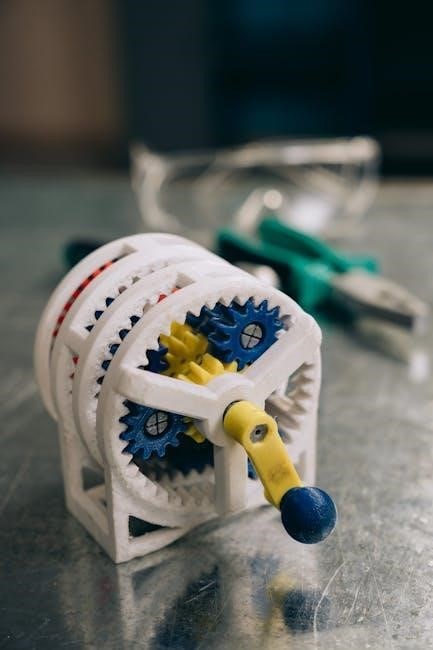
The Ingersoll-Rand Model 2475 Parts Manual is an essential guide for safe operation, maintenance, and repair. It provides detailed lists of components, descriptions, and specifications, ensuring proper functionality and longevity. The manual emphasizes the importance of using genuine parts to maintain performance and warranty validity, while also outlining critical torque specifications for assembly and repair procedures.
1.1 Overview of the Ingersoll-Rand Model 2475
The Ingersoll-Rand Model 2475 is a high-performance, two-stage reciprocating air compressor designed for industrial and commercial use. It offers reliable operation with a maximum operating pressure of 175 psig and is available in 5 or 7.5 hp configurations. Built for durability, the compressor features a robust frame assembly, efficient intercooler systems, and advanced control mechanisms. Its design ensures continuous duty operation, making it suitable for demanding applications. The model is known for its high-quality construction and adherence to OEM specifications, ensuring optimal performance and longevity when maintained with genuine Ingersoll-Rand parts and following recommended maintenance procedures.
1.2 Importance of the Parts Manual for Maintenance and Repair
The parts manual is crucial for maintaining and repairing the Ingersoll-Rand Model 2475. It provides detailed component lists, descriptions, and torque specifications, ensuring accurate repairs. The manual helps identify and resolve issues like sludge buildup and excessive moisture, which can damage the compressor. It emphasizes the use of genuine parts to maintain performance and safety, while also outlining proper tightening sequences and calibration of torque wrenches. Adhering to the manual’s guidelines prevents premature wear, ensures system longevity, and maintains warranty validity. Regular reference to the manual is essential for technicians to perform efficient and reliable maintenance, safeguarding the compressor’s optimal operation and extending its service life.

Key Components of the Ingersoll-Rand Model 2475
The Model 2475 features essential components like the compressor frame assembly, valve plate assemblies, bare compressor pump, intercooler assembly, and control systems, ensuring reliable and efficient operation.
2.1 Compressor Frame Assembly
The compressor frame assembly is the structural backbone of the Ingersoll-Rand Model 2475, housing critical components like the pump and valve plates. It ensures alignment and stability, minimizing vibration and wear. Made from durable materials, it supports continuous operation and withstands rigorous industrial demands. Proper assembly and alignment are vital for optimal performance, as specified in the manual. Regular inspection and maintenance of the frame are recommended to prevent premature wear and ensure longevity of the compressor.
2.2 Valve Plate Assemblies
The valve plate assemblies in the Ingersoll-Rand Model 2475 are critical for efficient air compression and flow management. They are designed to optimize performance by ensuring smooth operation during the compression cycle. The manual highlights the importance of proper installation and maintenance of these assemblies to prevent issues like sludge buildup or excessive moisture, which can lead to premature wear. Genuine Ingersoll-Rand parts are recommended to maintain optimal functionality and reliability. Regular inspection and timely replacement of worn components are essential to uphold the compressor’s efficiency and longevity. These assemblies are integral to the compressor’s ability to deliver consistent and reliable performance in demanding industrial environments.
2.3 Bare Compressor Pump
The bare compressor pump is a fundamental component of the Ingersoll-Rand Model 2475, responsible for generating compressed air. It is designed for durability and efficiency, with precise engineering to handle high pressure and continuous operation. The parts manual provides detailed specifications for critical fasteners, emphasizing the importance of proper torque values to ensure safe and reliable performance. Regular maintenance, including inspections and timely replacement of worn parts, is crucial to prevent premature wear and maintain optimal functionality. Genuine Ingersoll-Rand parts are highly recommended to uphold the compressor’s performance and warranty. The manual also outlines a detailed torque tightening sequence to ensure proper assembly and prevent damage.
2.4 Intercooler Assembly
The intercooler assembly plays a vital role in cooling compressed air between stages, enhancing efficiency and reducing moisture buildup. It is designed to ensure optimal performance by lowering the temperature of the compressed air, which helps prevent damage to downstream components. The parts manual provides detailed specifications for intercooler components, including tubes, fittings, and brackets, ensuring proper installation and maintenance. Regular inspection and cleaning of the intercooler are recommended to maintain airflow and thermal efficiency. Genuine Ingersoll-Rand parts are essential for maintaining the integrity and performance of the intercooler assembly. The manual also includes diagrams and instructions for disassembly and reassembly procedures, aiding technicians in routine maintenance tasks.
2.5 Control Systems
The control systems of the Ingersoll-Rand Model 2475 are designed to manage compressor operations efficiently, ensuring safe and reliable performance. These systems include pressure sensors, timers, and electronic controllers that monitor and regulate compressor functions. The control panel provides clear indicators for pressure levels, temperature, and operational status, enabling quick troubleshooting. The manual emphasizes the importance of regular inspections and calibration of control components to maintain optimal performance. Genuine Ingersoll-Rand parts are recommended for replacements to ensure compatibility and reliability. Proper maintenance of the control systems prevents unexpected shutdowns and extends the lifespan of the compressor. The manual also outlines procedures for diagnosing and addressing common control-related issues, ensuring uninterrupted operation.

Torque Specifications for Critical Fasteners
Torque specifications for critical fasteners ensure proper assembly and prevent damage. Use calibrated wrenches to apply even pressure, following the recommended sequence for secure tightening.
3.1 Fastener Tightening Sequence
The fastener tightening sequence is critical to ensure even stress distribution and prevent damage to components. Always follow a crisscross pattern when tightening bolts and nuts, starting from the center and moving outward. This method helps maintain uniform pressure across the assembly. Tighten fasteners in two stages: first to half the recommended torque, then gradually increase to the final specification. Use a calibrated torque wrench to apply the correct force, as outlined in the manual. Avoid overtightening or applying uneven torque, which can lead to premature wear or failure. Proper sequencing ensures the integrity of the compressor frame and related components, guaranteeing optimal performance and longevity.
3.2 Recommended Torque Wrench Calibration
Proper calibration of torque wrenches is essential for accurate fastener tightening. Calibrate torque wrenches every six months or after heavy use to ensure precision. Use a certified torque tester or calibration lab to verify accuracy. Always follow the manufacturer’s calibration procedure for your specific wrench. Incorrect torque application can lead to premature wear or failure of critical components. For the Ingersoll-Rand Model 2475, use only calibrated tools to meet specified torque values. Regular calibration ensures compliance with safety standards and maintains the compressor’s performance. Refer to the manual for detailed calibration guidelines and torque specifications for each fastener type. Proper calibration is vital for safe and reliable operation.

Safety Guidelines for Handling and Maintenance
Always wear protective gear and follow proper handling procedures to prevent injuries. Adhere to torque specifications and use genuine parts to avoid safety hazards and ensure reliable performance.
4.1 Precautions for Avoiding Premature Wear
To prevent premature wear on the Ingersoll-Rand Model 2475, regular inspections and maintenance are crucial. Ensure all fasteners are tightened to specified torque values and follow a criss-cross pattern. Use only genuine Ingersoll-Rand replacement parts, as non-OEM components can lead to increased wear and safety risks. Lubrication levels should be monitored and maintained as per the manual’s guidelines. Avoid overheating by ensuring proper airflow around the unit and addressing any issues with intercooler efficiency. Regularly check for sludge buildup in lubricants and address excessive moisture in the system to prevent corrosion and wear. Adherence to these precautions will ensure optimal performance and extend the lifespan of the compressor.
4.2 Importance of Genuine Ingersoll-Rand Replacement Parts
Using genuine Ingersoll-Rand replacement parts is crucial for maintaining the safety, performance, and longevity of the Model 2475 compressor. These parts are engineered to precise specifications and made from high-quality materials to ensure optimal functionality. Genuine parts are backed by the manufacturer’s warranty, offering added protection and peace of mind. Non-OEM parts may compromise safety, lead to premature wear, and void the compressor’s warranty. Always insist on genuine Ingersoll-Rand parts to guarantee reliability, efficiency, and adherence to safety standards. This ensures the compressor operates as intended, minimizing downtime and extending its service life.

Troubleshooting Common Issues
This section identifies and resolves common problems such as sludge buildup in lubricants and excessive system moisture. Early detection prevents premature wear and ensures optimal performance.
5.1 Identifying and Resolving Sludge Buildup in Lubricants
Sludge buildup in lubricants is a common issue caused by contamination from moisture, debris, or degraded oil. It can lead to premature wear on moving parts and reduced compressor efficiency. Regular oil analysis is recommended to detect sludge early. Signs include increased pressure drops, reduced flow rates, or visible sludge in the oil reservoir. To resolve this, drain and flush the system thoroughly, replacing the oil with genuine Ingersoll-Rand lubricants. Additionally, inspect and replace filters to prevent re-contamination. Proper maintenance and using high-quality parts ensure optimal performance and longevity of the compressor.
5.2 Addressing Excessive Moisture in the System
Excessive moisture in the Ingersoll-Rand Model 2475 can lead to rust, corrosion, and sludge buildup, compromising system performance and longevity. Moisture often enters through improperly sealed connections or during cooling processes. Regularly inspect and replace desiccant filters to minimize moisture ingress. Ensure proper ventilation in the compressor room and maintain consistent operating temperatures. If moisture is detected, drain the system and flush it with a water-resistant lubricant. Always use genuine Ingersoll-Rand replacement parts to ensure compatibility and performance. Addressing moisture issues promptly prevents damage and maintains the compressor’s efficiency and reliability over time.